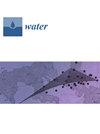平面和汇集式阶梯水道水流特性和能量消耗的数值分析
IF 3
3区 环境科学与生态学
Q2 ENVIRONMENTAL SCIENCES
引用次数: 0
摘要
与传统的阶梯式溢洪道相比,汇集式阶梯溢洪道的水力性能得到的认可较少。关于汇集式阶梯溢洪道在管理水流动态方面的有效性,以往的研究主要集中在研究不同的阶梯配置和不同的溜槽角度如何增强溜槽上重力流的能量消耗。然而,现有文献并未深入探讨优化性能的潜力和合理设计的重要性。本研究旨在探索汇集式阶梯溢洪道的新配置,并将其与传统的阶梯溢洪道设计进行比较,以提高水力效率并最大限度地消散能量。本研究考察了两种类型的阶梯式溢洪道配置--两种平式配置和两种汇集式配置,每种配置有十个阶梯。使用计算流体动力学(CFD)技术,如流体体积法(VOF)和可实现的 k-ε 湍流模型,对滑道坡度为 26.6°的两相流进行分析。最初,该模型通过比较各种水力参数与实验数据进行了验证。这些参数包括水深、滚筒长度、跳跃长度、临界深度比和顺序深度。通过数值模拟对两种阶梯式几何结构的水力性能进行了评估,以研究平面阶梯式溢洪道和汇集阶梯式溢洪道的几何结构如何影响下游的水流特性、能量耗散、流速、压力分布和弗劳德数。研究分析了平阶梯和汇集阶梯式溢洪道在六种不同流速条件下的下游流动特性、最大能量耗散率、深度平均流速、静压和横向压力等值线。研究结果表明,与汇集式结构相比,平阶梯结构的能量耗散较低。与平阶梯相比,汇集阶梯上水流的相对能量损失更多。此外,与平面结构相比,水池结构在能量耗散和流动稳定性方面表现更好。汇集式阶梯溢洪道的消能分别增加了 34.68% 和 25.81%。此外,与平面阶梯结构相比,情况 2 和情况 4 的深度平均流速和压力分布都有所下降。本文章由计算机程序翻译,如有差异,请以英文原文为准。
Numerical Analysis of Flow Characteristics and Energy Dissipation on Flat and Pooled Stepped Spillways
The hydraulic performance of pooled stepped spillways has received less recognition compared to the traditional stepped spillways. Regarding the effectiveness of pooled stepped spillways in managing flow dynamics, previous studies have focused on investigating how different step configurations and varying chute angles can enhance energy dissipation in gravity flow over the chute. However, the potential for optimal performance and the importance of proper design have not been thoroughly explored in the existing literature. This study aims to explore new configurations of pooled stepped spillways and compare them to traditional stepped spillway designs to enhance hydraulic efficiency and maximize energy dissipation. The study examines two types of configurations of stepped spillways—two flat and two pooled configurations, each with ten steps. Using the computational Fluid Dynamics (CFD) technique, such as Volume of Fluid Method (VOF) and the realizable k-ε turbulence model for two-phase flow analysis with a 26.6° chute slope. Initially, the model was validated with experimental data by comparing various hydraulic parameters. These parameters include water depth, roller length, jump length, ratio of critical depth, and sequent depth. The hydraulic performance of both stepped geometric configurations was evaluated through numerical simulations to examine how the geometries of flat and pooled stepped spillways influence flow characteristics, energy dissipation, velocity, pressure distribution, and the Froude number at the downstream. The study analyzed downstream flow characteristics, maximum energy dissipation rates, depth-averaged velocity, static pressure, and pressure contours at the lateral direction under six different flow rates in flat and pooled stepped spillways. The findings indicate that flat-step configurations exhibit lower energy dissipation compared to pooled configurations. The relative energy loss of flow on pooled steps dissipates more energy than on flat steps. Furthermore, it is observed that the pooled configurations performed better for energy dissipation and flow stability compared to the flat configurations. The energy dissipation increased in pooled stepped spillways by 34.68% and 25.81%, respectively. Additionally, the depth-averaged flow velocity and pressure distribution decreased in case 2 and case 4 compared to the flat-step configurations.
求助全文
通过发布文献求助,成功后即可免费获取论文全文。
去求助
来源期刊

Water
WATER RESOURCES-
CiteScore
5.80
自引率
14.70%
发文量
3491
审稿时长
19.85 days
期刊介绍:
Water (ISSN 2073-4441) is an international and cross-disciplinary scholarly journal covering all aspects of water including water science and technology, and the hydrology, ecology and management of water resources. It publishes regular research papers, critical reviews and short communications, and there is no restriction on the length of the papers. Our aim is to encourage scientists to publish their experimental and theoretical research in as much detail as possible. Full experimental and/or methodical details must be provided for research articles. Computed data or files regarding the full details of the experimental procedure, if unable to be published in a normal way, can be deposited as supplementary material.
 求助内容:
求助内容: 应助结果提醒方式:
应助结果提醒方式:


